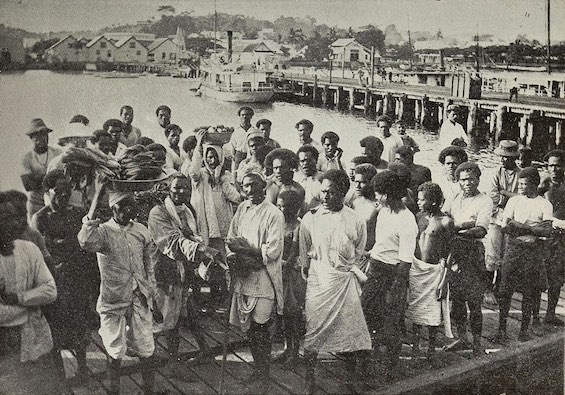
For most Americans and Europeans, the name Fiji conjures up images of golden beaches, lush jungle landscapes, and coconut palms waving in a gentle breeze. But until about a century ago, the island nation was the scene of one of the more distasteful practices of the British Empire. Then, tens of thousands of impoverished Indians served there for five-year terms as indentured servants, mostly on the sugarcane plantations that were central to Fiji’s economy. They were effectively enslaved—overworked, underfed, housed in deplorable conditions, and sometimes brutally treated by their overseers. This is the sad reality Nilima Rao brings to light in her clever and engaging new South Pacific mystery novel, A Disappearance in Fiji.
Estimated reading time: 5 minutes
A Sikh police detective in the South Pacific
It’s 1914, and war has broken out in Europe. Sergeant Akal Singh, a Punjabi Sikh in the Fiji Constabulary, has been in the country for just six months. He had been a crack investigator, highly valued in Hong Kong, when a terrible blunder forced his superiors to banish him to the islands. Now he’s under the thumb of Inspector-General Jonathon Thurstrom, head of the police force for the fledgling colony. And Thurstrom is hostile to him—more so, even, than other local British, who are almost uniformly racist. Ever since arriving in-country, Thurstrom had kept Akal on a dead-end assignment investigating the Night Prowler, a Fijian man who exposes himself to children. Others, lower-ranking in the capital’s force, get the plum assignments. This, despite the fact that he is the most senior officer and clearly the most capable detective.
Now Thurstrom has sent him off on another case that promises to be even worse for Akal’s prospects. According to conflicting reports, a young female indentured servant (“coolie”) has either run away or been kidnapped from a plantation in the interior. It’s seems likely that something is up there because a local priest is making noise about trouble in the newspaper. But Akal’s charge is to find her and avoid making a fuss that might upset the British man who owns the plantation.
A Disappearance in Fiji by Nilima Rao (2023) 289 pages ★★★★★

A case fraught with complications
Once he arrives at the Parkins plantation, Akal knows the case of the missing woman, whose name is Kunti, is fraught with complications. The owner’s wife insists that Kunti had run off with Mr. Brown, the plantation’s overseer. But others aren’t so sure. And, no sooner does Akal begin to interview the laborers on the plantation and former indentured servants in a nearby village than he comes to understand how brutally Brown and Parkins have been treating them. And this poses a grave problem for Akal.
A “Delegation for India’s Relations with Fiji was visiting to review the Indian indentured servitude program” in response to mounting agitation to end it. And the head of the delegation has made Akal promise to report on the conditions he finds at the Parkins plantation. If he does so, he will enrage the inspector-general. The last thing the police chief wants is to undermine the plantation economy. And there’s no doubt ending the influx of Indians would do just that. Akal is conflicted.
At the same time, Akal’s investigation into the comings and goings of Brown, Parkins, and Mrs. Parkins begins to turn up disturbing suggestions that Kunti had not run away, as the owners insist. And she may not even be alive. This is clearly not a case that will propel Akal to glory.
The historical setting
From 1834 until midway through the First World War, British officials enlisted some 1.2 million poverty-stricken and often starving Indian peasants to work the fields in such colonies as Trinidad, Jamaica, and Mauritius. For most, the move overseas doubtless represented a reprieve from a hopeless existence wracked by droughts, floods and famines. But all too often the conditions they met on arrival in their new homes were little if any better. Still, the indentured servitude of so many helps explain the vast Indian diaspora today. As Nilima Rao writes in an author’s note, “From 1879 to 1916, over sixty thousand Indians went to Fiji as indentured servants, or girmityas. About half of them cashed in their return trip to India, leaving about thirty thousand to start a new life in Fiji. My great-grandparents were part of this thirty thousand.”
A Disappearance in Fiji is set in the island of Viti Levu, the main island of what today is the Republic of Fiji. It’s one of the more than 330 islands that comprise the nation. (Only about 110 of the islands are permanently inhabited.) The archipelago lies about 1,300 miles north-northwest of New Zealand in the South Pacific. Fiji was a British colony from 1874 until 1970, when it gained its independence. A century ago, when the novel is set, the island’s economy was dominated by sugarcane plantations. Today, tourism is the leading industry, although the nation’s economy is one of the most developed in the Pacific, given its abundant natural resources. The population today is about one million.
About the author

Nilima Rao is an Australian of Indian heritage born in Fiji. Her ancestors emigrated from India to Fiji as indentured servants, like those she writes about in her novel. A Disappearance in Fiji marks her debut as a novelist. Rao works a “dreaded day job wrangling data.” She lives in Melbourne.
For related reading
Check out Top 10 historical mysteries and thrillers.
You might also enjoy my posts:
- Top 10 mystery and thriller series
- 20 excellent standalone mysteries and thrillers
- 30 outstanding detective series from around the world
- Top 20 suspenseful detective novels
And you can always find my most popular reviews, and the most recent ones, on the Home Page.




























I’ve been to Fiji twice, the first time right after a coup. This novel sounds like it really captures the vibe of the ethnic divide during the early years. I vividly recall seeing a long chute full of sugar filling a ship at the dock, knowing that the ethnic Indian population had been brought to the country to raise sugar cane and wondering if Cadbury chocolate was the reason. Thanks for discovering this novel!
Thank you! As I understand the history of the chocolate industry, Cadbury may well have been a factor. But the unquenchable English thirst for tea undoubtedly loomed larger.